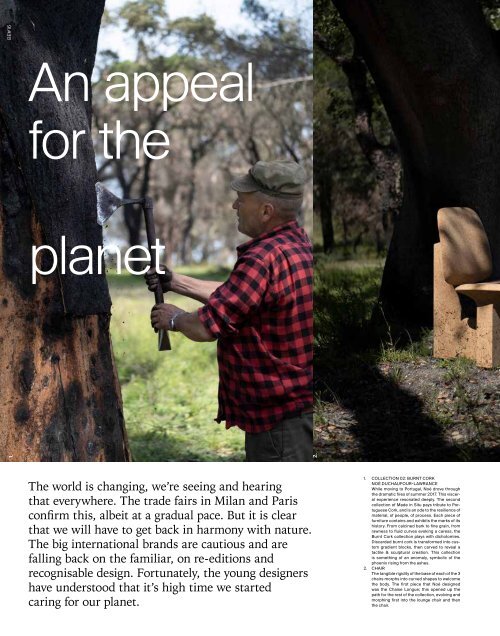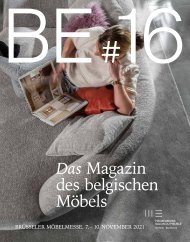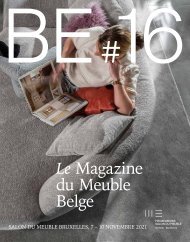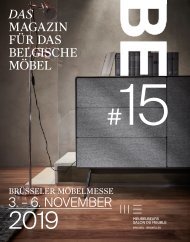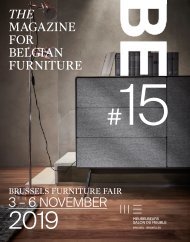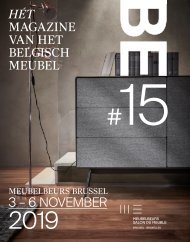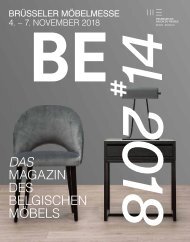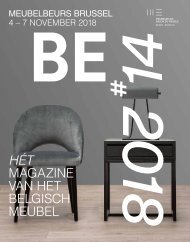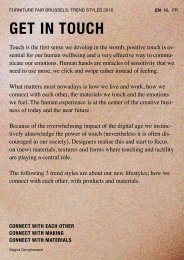You also want an ePaper? Increase the reach of your titles
YUMPU automatically turns print PDFs into web optimized ePapers that Google loves.
BE#16<br />
An appeal<br />
for the<br />
Reconnect & look forward<br />
We continue to exhaust and waste natural resources, we continue to pollute our<br />
environment, we disturb the balance of biodiversity and destroy natural habitats.<br />
The Covid-19 virus, with a worldwide pandemic as a consequence, is one of the<br />
many reactions to our actions, as are the extreme weather conditions resulting<br />
from climate change.<br />
Sustainability alone is no longer enough. We must come up with restorative and<br />
regenerative solutions. Design must become a catalyst for lasting, sustainable,<br />
environmentally-conscious thinking and action. Long-term thinking must take<br />
centre stage: we need to design for future generations. We must now acknowledge<br />
what went wrong and take responsibility for our future. Can we create a<br />
legacy of which we can be proud? This is a gigantic task and responsibility for<br />
designers. This appeal is a call to the furniture industry and trade to support<br />
them in every possible way.<br />
BRUSSELS FURNITURE FAIR<br />
planet<br />
The power of design<br />
But let’s make this a positive story, because today the work of many designers,<br />
artists and makers revolves around the circular economy and sustainability, for<br />
example waste management, recycling and upcycling through interdisciplinary<br />
collaborations, the encouragement of traditional crafts, the sharing of knowledge,<br />
research, social participation and imagination. New, hopeful collaborations<br />
are being forged between designers, knowledge institutions, organisations<br />
and industry.<br />
2 3<br />
We must believe in the power of creativity to transform society. Money, governments<br />
or science cannot solve complex global problems alone. We need fresh<br />
ideas, alternative strategies and provocative thoughts. Whilst we work towards<br />
a global circular economy, we must be aware of local challenges and opportunities.<br />
We will also need to make better use of energy, becoming more efficient and<br />
generating less waste. The pandemic and the lockdowns have made many of us<br />
pause to consider the way we live, and an awareness has grown that things need<br />
to be done differently.<br />
1.<br />
2.<br />
‘Every little helps, but it<br />
doesn’t solve everything.’<br />
The world is changing, we’re seeing and hearing<br />
that everywhere. The trade fairs in Milan and Paris<br />
confirm this, albeit at a gradual pace. But it is clear<br />
that we will have to get back in harmony with nature.<br />
The big international brands are cautious and are<br />
falling back on the familiar, on re-editions and<br />
recognisable design. Fortunately, the young designers<br />
have understood that it’s high time we started<br />
caring for our planet.<br />
1. COLLECTION 02: BURNT CORK<br />
NOÉ DUCHAUFOUR-LAWRANCE<br />
While moving to Portugal, Noé drove through<br />
the dramatic fires of summer 2017. This visceral<br />
experience resonated deeply. The second<br />
collection of Made in Situ pays tribute to Portuguese<br />
Cork, and is an ode to the resilience of<br />
material, of people, of process. Each piece of<br />
furniture contains and exhibits the marks of its<br />
history. From calcined bark to fine grain, from<br />
rawness to fluid curves evoking a caress, the<br />
Burnt Cork collection plays with dichotomies.<br />
Discarded burnt cork is transformed into custom<br />
gradient blocks, then carved to reveal a<br />
tactile & sculptural creation. This collection<br />
is something of an anomaly, symbolic of the<br />
phoenix rising from the ashes.<br />
2. CHAIR<br />
The tangible rigidity of the base of each of the 3<br />
chairs morphs into curved shapes to welcome<br />
the body. The first piece that Noé designed<br />
was the Chaise Longue; this opened up the<br />
path for the rest of the collection, evolving and<br />
morphing first into the lounge chair and then<br />
the chair.<br />
→ Text: Siegrid Demyttenaere<br />
Milan, back & forward<br />
Under the influence of the pandemic our bedrooms became offices, our kitchens<br />
schools, and our terraces or balconies the places where we wanted to make our<br />
social engagement visible. In this hybrid environment, the private was increasingly<br />
obliged to give way to the public, whilst many of the usual social functions<br />
were actually suspended. Could we see the consequences of this in Milan or<br />
Paris?<br />
The trend towards smaller and more flexible living spaces has certainly been<br />
rolled forward a year. We see large, comfortable sofas and chairs at the small<br />
Supersalone in Milan. As a sign of ‘keep your distance’, but no doubt also to<br />
achieve maximum peace and relaxation, whilst the design language is in fact<br />
understated, as is the material use.


